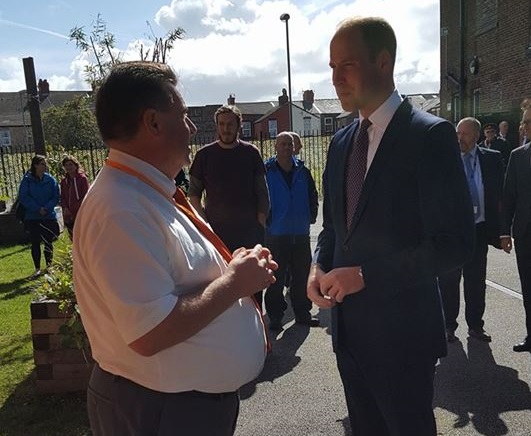Prince William has visited a dog rescue in Merseyside to learn how dogs in rescue are helping people with mental health problems.
Paul Dunne, the founder of Merseyside Dogs Home who met with Prince William told us that his rescue isn’t just there to help dogs in the community, they want to help people too.
Dunne discussed their work with the Prince, who has been vocal in raising awareness to debunk the stigmas around mental health alongside his brother.
“As a new charity we did not want to be just another dogs home, obviously our first charitable objective is about saving the lives of lost dogs but our second and third objectives are about people.
“On average, it takes just thirty-four days to nurture a dog back to physical and mental health. The Prince was interested in the parallels this has with people and how people with mental health help themselves to grow in confidence and ability by helping dogs in need.”
Rehabilitating a dog involves physical recuperation, then mentally, giving them the nutrients they need for a good diet, providing enrichment activities and guiding them back to full health so they re-join society as companion pets.
People join to explore the dogs journey, helping them, whilst at the same time taking a journey of self-discovery themselves. The development of both dogs and humans reaching their full potential is our core philosophy at the home, under the Paws for Life Programme.
This programme is both unique and cutting edge, especially with the homeless, those with poor mental health and many fragmented from society. We work with many people who have complex needs. The work is receiving national recognition, especially the meeting to discuss the Paws for Life projects with his Royal Highness the Duke of Cambridge.
Locally the Dogs Home works with Merseycare Life Rooms and The Whitechapel Centre. A number of courses are accredited and in big demand, both by far the most popular course with the organisations.
Tina Meany who helps to deliver the course says “learners are fabulous, they soak up the information about the dogs needs and then begin to apply the same principles to their own life style, one of the most talked about subjects is the emotional state of a dog, we use a traffic light scheme developed by David Campbell, a dog in the green zone is relaxed and happy to learn. In the amber zone starts to become stressed affecting its ability to learn and cope. In the red zone the dog cannot cope at all, becoming over whelmed with the environment and experiences.”
Students are taught how to work with dogs in the red zone, working through the amber zone and into a happy place into the green zone. Many participants on the course point out to us that this is occurring in their own life, we then can apply many of the principles. For instance, the importance of nutrition and good diet in recovery.
The home does not just work with the homeless and people struggling with mental health it also undertakes activities with children, through its Bark and read programme, even providing assistance dogs to help children with disabilities.
Paul says, “At the home we believe every dog should reach its full potential and use the work of Stanley Coren: The Intelligence of Dogs, in identify different types of intelligence and then working with that dog to reach its full potential, be it obedience, instinctive or adaptive inelegance.”
During the past year the home has helped 564 companion dogs to be adopted as pets, had twenty one PAT dogs at 200 events engaging with 1,000 individuals, Bark and read to three hundred and fifty children. Had 48 people develop new skills and training.
It is hoped that the Duke of Cambridge’s visit will help promote more activities in the region where dogs can help people recover and live a healthy lifestyle.
